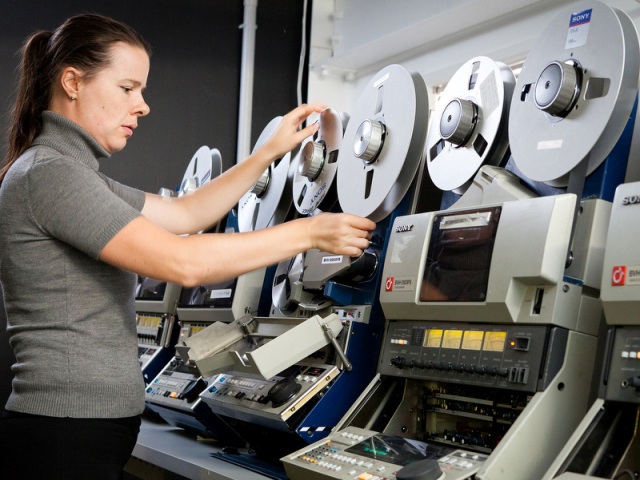Analog pasts preserved in digital futures

According to UNESCO, thousands of hours of culturally significant audiovisual footage — including the original moon landing tapes — have been lost forever. Magnetic tapes degrade and often physical formats can disappear and break. So how can we preserve our cultural legacy? The answer is digitisation.
DAMsmart is an Australian company that has been around since 1982. Employing a dozen staff in offices in Sydney and Canberra, it is one of the only companies in Australia that specialises in the preservation and conversion of analog records to digital media.

From tape to beyond! (Credit: DAMsmart)
With a client list that runs from the Commonwealth Parliament to broadcasters like the ABC and cultural organisations like the National Library, DAMsmart has played an incredibly important role in ensuring that the footage of yesterday will be available to view in years to come.
ZDNet Australia spoke to general manager Joe Kelly and business manager Adam Hodgkinson from DAMsmart to get an insight into what it takes to ensure that our recorded cultural legacy can last for generations to come.
"It's a big thing, there's reports from UNESCO that hundreds and thousands of hours of audiovisual heritage around the world is being lost because the carriers [of this content] are sitting there and degrading. We are losing the visions of our heritage, not only in Australia but also globally," said Hodgkinson.
Preservation and access
The company has two main goals: preservation and access. By converting clunky and fragile analog formats that degrade easily into a more robust and flexible digital format, like JPEG 2000, not only do we ensure that audiovisual recordings have a longer lifespan, but that they're also easier for the general public to access.
"[While one outcome is the] preservation of culturally significant collections, the second major outcome is, through that digital preservation process... we are able to assist organisations to provide much easier forms of contemporary access to the content," said Kelly, giving examples of streaming video in galleries, holding virtual exhibitions online and "all these kinds of funky new consumption methods".
Political machinations and automations
Currently DAMsmart is in the process of digitising over 50,000 hours of footage from parliamentary sessions in 12 months. If you do the maths, there's only approximately 8765 hours in a year. So how do they do it?
DAMsmart runs 14 streams that are constantly encoding and storing audiovisual footage 24 hours a day, seven days a week. Using automation and automated quality control, it is able to effectively digitise, store and manage audiovisual content without the need for continuous staff supervision.
"The operators have definitely caught up on their political history," joked Hodgkinson.
"We've had 55,000 hours go through, we do play the odd game of trivia around MPs and senators on the video wall," said Kelly.
"Thank goodness for automated analysis and quality control systems. It has thankfully meant that we didn't have to sit there and watch 55,000 hours of parliamentary footage — I don't think anyone could bear that."
As you can imagine, the most important markets for DAMsmart are the public sector and cultural organisations.
"The cultural sector is a very significant market for us; we've completed successful media preservation projects for a range of organisations including the national library. We're currently performing a film digitisation project for the national gallery of Australia," said Kelly.
"They have a very good understanding of their preservation and conservation obligations but they don't necessarily have the skills and infrastructure to undertake that type of work themselves," he said.
Open standards for an open future
While the business ultimately offers a service to its customers, it tries to encourage its clients to choose open formats as opposed to proprietary formats that can often lock you into a single vendor relationship. Currently DAMsmart uses JPEG 2000, which is an internationally recognised and mathematically lossless format.
"We will always meet the requirements of the client, so if they request something in an Apple codec, we'll deliver that," said Hodgkinson.
"We are advocates of open standards formats, our files are backed up using TAR which is an open standards format, we try where possible to use open formats." It's a sentiment that underpins Kelly's ethos, having worked with the National Film and Sound Archives for close to a decade. Having a background in cultural preservation, he actively encourages the use of open standards as opposed to proprietary ones.
"We've been very conscious of that and we're very conscious of not going down that pathway and to offer our customers a much more open and transparent service which lets them take a digitised collection and then do with it what they want," he said.
"I guess this is one of the key things that differentiate us from people who are looking to do similar type work in the market."
While companies like DAMsmart are helping in the fight against the possibility of a digital dark age where arcane file formats are unable to be read and accessed because of the loss of machines and decoders to read these formats, Kelly acknowledges that nothing is "future-proof".
"I hate the term 'future-proof' because I don't believe there is such a thing particularly in our game but I guess we are trying to give customers as many options as possible for the future management of their collection," he said.